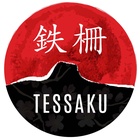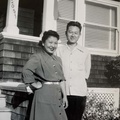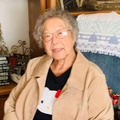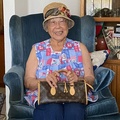Did you get the sense that for whatever reason, Minidoka’s security felt more relaxed than the other camps?
In my diggings I found the April 7th meeting of DeWitt, Eisenhower, and the ten Western governors in Salt Lake City. And on page four it says ‘distinction between internment and evacuation.’ It spelled out clearly the difference between the two. And then, poor Mr. Eisenhower had a problem with sleeping because knowing American citizens were locked up behind barbed wire and armed guards, he couldn’t sleep at night. So in June, he turned the duties over to General Myer, that’s how he got involved.
And I didn’t get to go to it, but there was a conference here in L.A. in 2010. And they could not agree upon whether if internees was separate from evacuees. They were discussing the terminology, and yet, if you look at the original definitions of internment and evacuees, they’re two separate tracks. I found fifteen differences between the two groups. But all these authors are copying everybody else. In fact in one book I thumbed through, they used evacuee and internee in the same chapter, as being in the same group of people.
So they were interchanging the two. What would you say about the terminology, if you were to call the camps for what they were – incarceration?
Yeah. We were first excluded, and they also had restrictions and prohibited areas where any aliens could not go. And I also found another government document that said ‘there are several groups we’re concerned about that could be involved in spy and sabotage and could be a threat to our internal security: German aliens; Japanese aliens; Italian aliens; people who might be involved in sabotage and espionage; and American-born Japanese. That’s in that government document.

Wow.
So they labeled us and that they didn’t put American Germans or American Italians in there. And later I found two other documents that gave them special privileges, but they didn’t include Japanese Americans in any of these. And one was the curfew law that Hirabayashi and Yasui tried to confront. I’m going through the brief of Hirabayashi, and it spelled out that people could get a permit to stay out beyond the curfew hours or to travel more than five miles from their home. German or Italian, no Japanese listed. And later when the exclusion order came out on the West Coast, they had an exclusion from evacuation order. If you’re over seventy years of age, you were German or Italian, if you have someone in the military service or relative or someone who died in the service from December 7th on, all three of these categories had two boxes to check, ‘I’m German, I’m Italian,’ but no Japanese.
It just shows you how much it was only about race.
Well it was money. Also adding to that fact, there’s a big misnomer about, ‘Oh my gosh we lost everything.’ Well, in my digging, I found a government document that said ‘We’re not liable but we’re providing you with free warehouse space.’ And on the flip side of the sheet it has by room all the different furniture you’d have. And then, I found another document that said with some humility tied into it, ‘If we’re going to remove these people from their homes, it’s only humane to provide storage space for them.’ And the government did provide storage space. My parents left their belongings with the great uncle and aunt’s house and they had a caretaker take care of it. But one of the staff members that used to be at the museum, he got his family records and it had ten crates that were stored in a paid for warehouse. And then after the war, apparently they were living in Northern California and they wanted to get their crates shipped to Hawaii where they were moving. ‘Course the government didn’t pay for that but it said the crates and weights of them. So people did store things.
Either nobody really knew how to take advantage of it or I wonder–
And nobody talks about the form that was available. You took inventory, put down what you had, and they made three copies of it. They kept those and you kept yours and after the war you turned it in and got your things shipped to your home in the U.S.
And how was the decision made for your parents to go do sugar beet farming?
On that April 7th meeting, the WRA–Eisenhower and DeWitt–were trying to feel out the state’s governors in how accepting would they be to put us in their states. And naturally they all said no. Carr of Colorado was the only one who said ‘Maybe.’ But by the end of the month and early May all this pressure came onto the governors from sugar beet farmers and sugar beet companies. Because the government ’41 had a quota, Idaho had 48,000 acres of sugar beets that they would plant. The government lifted the quota, and I came across a flyer that said, ‘Plant more acres of sugar beets.’ So Idaho had to plan 100,000 acres instead of 48, but because of the question of labor, they ended up planting only 85,000 acres. And right away they were recruiting city people, women and high students, and they talked to the chambers of commerce and got the stores to close down for half or all day while their employees went out to block and thin the beets. The sugar beet seeds were all stuck together and at that time they didn’t have a way to separate them. So they’d just planted a whole row of sugar beet seeds and they would all be too close together. So you’d take a short-handled hoe, whack out a section, that left a small group plus some weeds, then you go and hand-pick and leave the strongest one. So now they had space to get water and nutrients and had space to grow. When they’re harvesting them, they’re usually running about four to five pounds. These are not like the red beets you eat. These are large and more cone shaped.
Do you remember what that decision was like for your parents to sign up for farming?
The only things is in ’92 when I got the family records from the National Archives, I found the application form for seasonal leave, and then there were two other follow up letters from the government saying ‘We’re changing the date you can leave and changing the date you have to come back.’ Because these were seasonal. And Idaho had the sugar beets and potatoes. I remember helping in the potato harvest. Today it’s done by automation, you don’t have to have all the handpicking. We had two ways to pick the potatoes. One, my mom made kneepads so we could go around on our knees and fill up two bushel baskets into a gunny sack and you set it aside, and you got paid ten cents. Of course cost of living in those days was very low. And the Okies and Arkies, which is an improper term to use today [laughs], but they were out there, and the migratory workers were working in the fields with us. And they would take a wooden frame tied to their back and they’d hook on the gunny sack, then drag it between their legs and pick up the potatoes until they have a full sack.
How much per month were your parents paid?
It was hourly wage and piece work. You might get paid by the hour or so many dollars an acre. And then when we harvested potatoes that was piece work, ten cents a bag. And when you did the sugar beets, it was so much per ton of harvest.
You were young, but do you remember what you felt at the time after being uprooted?
I didn’t make any real conclusions and or anything really impress me. Other than I’m living here and suddenly I’m living somewhere else with a lot of Japanese people.
Oh, that’s right. How was that change for you where now you were with all Japanese?
Most of my recollections as a child are about life outside the center. My fourth third grade class was at the farm labor camp with the migratory workers seated on the third bench, third grade, all of the classes were in one room were taught by one teacher. I remember playing with different cultural groups in the farm labor camp, beside some of the farm kids around the labor camp. I don’t remember playing with any of the center children. I remember my first teacher in Twin Falls Bickel elementary school, Dryden. I enjoyed her class, the art work of paint on water and dipping the paper in the water, picking up the paint and giving it a mixed pattern. I was also in the winter assembly, which I believe was the story of baby Jesus, I played one of the announcers. My city friends were all of European ancestry. I got to know several of them, Kenneth Boyd, Robert Inama, Clarence Sweet whom I sat behind. My few Japanese American friends lived in the labor camp as there were not many Nisei my age and most Sansei were younger. Howard Takahashi, later known as the well known Asian artist Munio Makauchi, and I sort of got along. Tommy Enoki got to help in my dad sharecropping bulb onion field one year. The Higashi family which got an opportunity to visit in Oakland after the war years.
At the farm labor camp we played many types of children games. And my classmates all treated me like another American! Except one little older girl, for some reason I was in the hallway during class time and this girl passed me by, and I didn’t know girls knew that many swear words. [laughs]
Oh no.
Reflecting back upon it, I was thinking, ‘Okay she might have somebody who got killed in the attack on Pearl Harbor or captured in the Philippines, where she might have some anger. That was the only time in my life, that I know of, that I really experienced another case of prejudice.
And when did your family leave Idaho?
’49. My mom passed in ’48 and so my dad stayed there a year and was working with a Mexican immigrant crew. He would go out and get the contracts for the work in the fields and then in ’49 he figured he couldn’t make enough of a living. Because in ’48, in order to help ends meet my dad was growing green onions and we’d go out in the fields in the morning, pick them, bring them back, put them in a big galvanized tub, strip off the yellow leaves, and then put them in bundles, trim the roots and then he would take it down to Safeway store. They could put it out directly and they wouldn’t have to clean them.
So you did stay in Idaho even after the war was over.
My dad was a produce buyer and truck driver and the business for James Watanabe folded when he left. So there was nothing to go back to. And then my dad one year sharecropped with this Mr. Keller which was within a mile where we were living. So that was my summer of weeding the field with Tommy Enoki. We were living in the barracks initially and then later in ’43 my parents were granted one of the two bedroom cottages. They had those on a road outside the main barrack area. So you’re in a house, self-contained. Hot water to go to the heater was heated by heating the water that was in the stove, so you’d have to run the stove even if you weren’t cooking. I remember it got so hot sometimes that when you’d turn the facet on for hot water steam came out. It didn’t have a safety valve on it so it could’ve blown up. It’s amazing the little tidbits I remember.
In the assembly center in Portland, two things stand out in my mind. One, when I left the building, there was barbed wire, then armed guards and a machine gun on the tower. I went to the restroom and saw five flush toilets facing away and five towards me. No partitions separating them. That was the men’s restroom; I’m certain the women’s was the same way. They put office type cubicle walls up and we had a cloth door for privacy and we had the folding canvas cots and straw-filled mattress to sleep on. The flooring had spaces between the boards because I remember dropping a dime and I had a hard time trying to get it out.
Very uncomfortable.
And when I went to Idaho, I remember more about living on the outside because that was about seven or eight months each year for three years instead of in the center. Because center’s life is routine, same thing everyday.
I imagine it was a little more interesting with having to be out and working a little bit.
Interacting with the public and going to public school. When my class here in L.A. celebrated its 50th anniversary, it dawned on me that had I stayed in Idaho, they would be celebrating their 50th anniversary also. I was in contact through one of my classmates through email and got the address to Twin Falls Pines News. I carefully figured out how many words would fit and it got published in the paper the day after their class meeting. I wanted to thank my classmates for treating me like a fellow American.
Wow, that’s very touching. I’m sure a lot of people saw it after it was printed.
I’m in a book called Dadly Wisdom. Jennifer Jordan, a Long Beach State professor interviewed fifty two fathers. So I got to put in my three pages of interview material. She also interviewed one of the 442nd vets. In mine, I got to mention my link with other people. A long time ago, I thought life was a rocky road, I had a lot of bumps in it getting locked up and everything. Life divides, the road divides.
And then later I said no, life is a ribbon. This ribbon could be rumpled, it could be rough, could be smooth, and it could also be divided and the difference is that the ribbons are on the maypole of life. So our ribbons crossed indirectly. So I figured all of that out. And my wife wanted to know what I wanted for a eulogy so I looked on sayings and I came upon Robert Frost – the road seldom travelled. That sort of describes my life, and I just added onto the end. So I don’t know if she’s going to read it or not, the kids can read it. I have left the forest, and I saw the maypole of life where my ribbon ended.
That’s beautiful.
The audio from the interview:
*This article was originally published on Tessaku on December 7, 2017.
© 2017 Emiko Tsuchida






